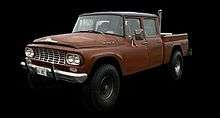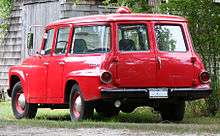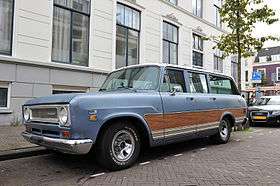International Harvester Travelall
The International Harvester Travelall is a model line of vehicles that were manufactured by International Harvester; four generations were produced from 1953 to 1975. Derived from the International light truck line, the Travelall was a truck-based station wagon. One of the first competitors to the Chevrolet Suburban, the Travelall was a forerunner of modern people movers and full-size sport utility vehicles.[1]
| International Harvester Travelall | |
|---|---|
 1970s Travelall badge | |
| Overview | |
| Manufacturer | International Harvester |
| Also called | Travelall |
| Production | 1953-1975 |
| Body and chassis | |
| Class | Full-size SUV |
| Layout |
|
| Body style(s) | 3/4/5-door wagon/SUV |
| Chronology | |
| Predecessor | International L series |
| Successor | none |
As International withdrew from light-truck sales, the Travelall and pickup truck lines were discontinued after the 1975 model year. The company exists today as Navistar International, and continues to make medium and large trucks.
Background
Prior to 1953, International Harvester did not produce a station wagon as part of its model range. Though traditionally derived from passenger cars, wood-bodied station wagons using International truck chassis were constructed on a third-party basis (called station wagons).[1] Moving away from woodies, following World War II, K-series panel vans served as the basis for airport people movers, adding windows and rear seats.
Following its introduction for the R/S light trucks, the Travelall would follow the development of the International pickup truck model line. In 1958, a third door was added, nine years before the Suburban; the fourth door came in 1961 (12 years before GM). The Travelette was a four-door crew-cab pickup, sharing its bodywork with the Travelall wagon.
First generation (1953-1957)
| First generation (R/S Series) | |
|---|---|
1954 R-110 Travelall in Belgium | |
| Overview | |
| Manufacturer | International Harvester |
| Model years | 1953-1957 |
| Body and chassis | |
| Class | Full-size SUV |
| Body style | 3-door wagon |
| Related | IHC R/S Series |
| Powertrain | |
| Engine | International Harvester 220 cu in (3.6 L) Silver Diamond inline-6 |
| Dimensions | |
| Wheelbase | 115.0 in (2,921.0 mm) |
International introduced the R-Series truck range in 1953, replacing the L-Series. Ranging from 1⁄2-ton trucks to heavy commercial trucks, the R-Series introduced the Travelall as a metal-bodied station wagon. Replacing the previous wood-bodied wagons, the Travelall was a windowed panel van with rear seats. In line with sedan-based wagons of the time, access to the rear seats of the R-Series Travelalls was gained by flipping up the passenger-side front seat. Two or three rear seats were offered; panel-truck "barn doors" were standard, with a wagon-style tailgate as an option.
In addition to the International name badge, a Travelall name badge was mounted on the front cowl. A few L-Series trucks were also produced with windows and seats in 1952, but whether the Travelall name was used that year is unknown.
The first-generation Travelall was offered in the R-110 series on the 115 in (2,921 mm) wheelbase. A 220 cubic-inch "Silver Diamond" I6 was rated at 100 hp.
In 1955, the R-Series was replaced by the S-Series, with the Travelall offered as the S-110 or heavier duty S-120. A BD 220 engine was similar to the R-Series. Four-wheel drive became a factory option for 1956.[1]
Second generation (1958-1960)
| Second generation (A/B Series) | |
|---|---|
 1959-1960 B120 Travelall | |
| Overview | |
| Manufacturer | International Harvester |
| Model years | 1958-1960 |
| Body and chassis | |
| Class | Full-size SUV |
| Body style | 4-door wagon |
| Related | IHC A/B Series |
| Powertrain | |
| Engine |
|
| Dimensions | |
| Wheelbase | 115.0 in (2,921.0 mm) |
| Length | 202.4 in (5,140 mm) (A-series)[2] |
Introduced in 1957 for the 1958 model year, the A-series (for "Anniversary", marking fifty years of International Harvester truck production) offered a 2nd passenger side door for improved access to the rear seats. Models A-100, A-110, and A-120 all came with 113 to 154 hp (84 to 115 kW) six-cylinder engines, with four-wheel drive optional on the A-120.[2] The design changes paralleled those of the A-series pickups.
Although only lightly modified, the B-Line trucks that appeared in 1959 offered upgraded options for the Travelall. Power steering, power brakes, V-8 engines, and other comfort, convenience, and visual appeal features were introduced to make the Travelall more mainstream and less commercial.[1] The Travelall was offered in the B-100/B-110/B-112 ½-ton range only in 4x2 form. The B-120 was a ¾-ton rated model and that was the only Travelall to come in four-wheel drive in this era. A B-122 model featured uprated springs for a higher GVW. The B-Line trucks carried on into the 1961 model year, when another mild facelift transformed them again into the C-Line.[1]
Third generation (1961-1968)
| Third generation (C/D Series) | |
|---|---|
_(cropped).jpg) 1968 1100C Travelall | |
| Overview | |
| Manufacturer | International Harvester |
| Model years | 1961-1968 |
| Designer | Ted Ornas |
| Body and chassis | |
| Class | Full-size SUV |
| Body style | 5-door wagon |
| Related | IHC C/D Series |
| Powertrain | |
| Engine | BD 240 Inline 6, BG 241 Inline 6, BD 264 Inline 6, 266 cu V8, 304 cu V8, 345 cu V8 |
| Transmission | Borg-Warner T19 4 Speed (2 wheel drive) |
| Dimensions | |
| Wheelbase | 119.0 in (3,022.6 mm) |
| Chronology | |
| Predecessor | B series Travelall 1959-1960 |
| Successor | D Series Travelall 1969-1975 |

In April 1961 the Travelall underwent the same changes as the pickup range upon which it was based. The new C-series Travelall benefitted from a whole new chassis with all new independent front torsion bar suspension.[3] Aside from the lower body, the most obvious visual difference were that the twin headlights were now mounted side-by-side, and a new grille of a concave egg-crate design. The wheelbase for the C-100/C-110 Travelall went up to 119 inches,[4] as the front wheels were mounted further forward. This adjustment increased the front clearance angle in spite of the lower body.[5]

This series was available either with a flip-down tailgate or two doors. The fold down gate had a window which wound down electrically. Development continued in a gradual fashion, becoming the D-series in 1965. A steady stream of new grilles and headlight treatments set the model years apart until a more thorough makeover took place in 1969. Until this model change, the Travelall had been considered merely a version of the related pickup truck; after the facelift the Travelall became a separate series.
Fourth generation (1969-1975)
| Fourth generation | |
|---|---|
 1971 Travelall 1010 | |
| Overview | |
| Manufacturer | International Harvester |
| Model years | 1969–1975 |
| Body and chassis | |
| Class | Full-size SUV |
| Powertrain | |
| Engine |
|
| Transmission |
|
| Dimensions | |
| Wheelbase | 119 in (3,023 mm) |
| Length | 203.9 in (5,179 mm) |
| Width | 77.6 in (1,971 mm) |
| Height |
|
| Curb weight |
|
The Travelall's (along with the 1000 D-series pickups on which it was based) final redesigned occurred early 1969 with a more modern look which echoed that of the smaller Scout. Available engine options for the 1000, 1100, and 1200 D-series Travelalls ranged from the unusual 232 cu in (3.8 L) AMC inline-six to three IHC V8s (of 304, 345 and 392 cu in [5.0, 5.7 and 6.4 L]) and four-wheel drive was optional on the 1100 and 1200s.[6] Power outputs ranged from 145 to 253 hp (108 to 189 kW). In 1973 and 1974, due to a short supply of IHC's own V8s, AMC's 401 cu in (6.6 L) V8 was available as an option called the V-400. The slow-selling six-cylinder was dropped for 1972, and by 1975 only IHC's own V8s were still available, with outputs down to 141–172 hp (105–128 kW).[7] A Bendix anti-lock brake system called Adaptive Braking System, operating only on the rear wheels, was available on later Travelalls and pickups (introduced in late 1971).[8] Due to the expense of the novel system, it was a rarely selected option.
.jpg)
Despite very high owner loyalty and satisfaction,[9] sales steadily declined and production of passenger pickups and Travelalls ended entirely in May 1975; production of the Scout continued until 1980.
Wagon Master
In 1973 and 1974 a modified Travelall was marketed as the International Harvester Wagon Master. The roof over the cargo section was removed to make a short pickup type bed. The target market for the Wagon Master were people who pulled fifth wheel RV trailers. The exposed cargo area provided the space needed to mount the fifth wheel for the trailer. The Wagon Master was very much like the Chevrolet Avalanche produced in the early and mid 2000s.
Variants
Travelalls were also produced with raised roofs and extended wheelbases for applications such as school buses, ambulances and airport limos. Many of these modifications were performed by the Springfield Equipment Company and were marketed by International.
Popular culture
In season 3, episode 19 of the CBS comedy-drama Northern Exposure the local shaman Leonard Quinhagak (played by Graham Greene) drives a Travelall. In subsequent episodes he drives a 1976 Chevrolet Chevelle Malibu wagon.[10]
In the 1993 drama film What’s Eating Gilbert Grape the characters Becky and her grandmother (played by Juliette Lewis and Penelope Branning, respectively) drive a 1972 two-wheel drive Travelall. The vehicle breaking down and leaving the two women stranded in a small Iowa town is a significant plot point in the movie.[11]
In the films Grumpy Old Men and Grumpier Old Men Max Goldman drives a 1974 Travelall.[12]
In the apocalyptic novel Lucifer's Hammer by Larry Niven and Jerry Pournelle, Harvey Randall uses a Travelall extensively.[13]
Folk musician Greg Brown sings about a Travelall in his song Laughing River.[14]
In the television show Z Nation, season 3, episode 7, the group of survivors is seen leaving a boathouse on a 4th generation Travelall.
In season 5 episode 19 of Hawaii Five-0, “Will the Real Mr. Winkler Please Die?” two blue Travelalls are used by the team to transport people to a remote safe house. It seemed unusual because all other vehicles in the show were Ford.
References
- Allen, Jim (1 November 2012). "1959 International Harvester B-120 Travelall – Four Wheeler Magazine". Four Wheeler Network. Archived from the original on 2018-01-07. Retrieved 2018-01-07.
- "The 1958 Station Wagons". Changing Times: The Kiplinger Magazine. Washington, DC. 12 (2): 22. February 1958.
- Sales Engineering Bulletin: C-line Travelall (PDF), International Harvester Company, April 1961, p. 10, CT-477
- Sales Engineering Bulletin: C-line Travelall, p. 3
- Sales Engineering Bulletin: C-line Travelall, p. 8
- Lamm, Michael (May 1971). "She's no beauty, but owners say, "Look beneath the skin!"". Popular Mechanics. NY, NY: The Hearst Corporation. 135 (5): 135.
- '75 International Recreational Vehicles, International Harvester, 1974, p. 12, AD-40333-C1
- Lund, Robert (February 1971). "Detroit Listening Post". Popular Mechanics. NY, NY: The Hearst Corporation. 135 (2): 46H, 48.
- Lamm (May 1971), p. 132. 92.4% of owners questioned said that they would buy another Travelall.
- http://www.imcdb.org/movie_98878-Northern-Exposure.html
- http://www.imcdb.org/movie_108550-What-s-Eating-Gilbert-Grape.html
- "Archived copy". Archived from the original on 2016-03-06. Retrieved 2016-03-05.CS1 maint: archived copy as title (link)
- http://www.bookrags.com/studyguide-lucifers-hammer/chapanal004.html#gsc.tab=0
- http://www.oldielyrics.com/lyrics/greg_brown/laughing_river.html
Further reading
- Crismon, Fred W. (2001). International Trucks: 100 Years 1907-2007. Crestline. ISBN 978-0970056726.
- Foster, Patrick (2015). International Harvester Trucks, The Complete History. Motorbooks. ISBN 978-0-7603-4860-4.
External links
- "International® 1010 Travelall®". International Harvester. 1972. Cite journal requires
|journal=(help) - "International Light-Duty Trucks and Scout". International Trails. 1961.
| Wikimedia Commons has media related to International Travelall. |